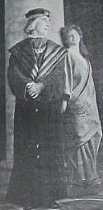
The Ladies Shakespeare
This was actually the play The Legend of Leonora, but the fourth act was dropped and a separate 50 minute piece as added.
This play was done at the Hollis Street Theater in Boston during the week of February 22, 1915. In the program for the play it was also subtitled Being One Woman's Reading of a Notorious Work of William Shakespeare, called 'The Taming of the Shrew,' Edited by J.M. Barrie.
The critics were not overwhelmingly impressed with the play, although they did have some good things to say about Maude Adam's performance.
"Miss Adams was not endowed by nature, inclination or disposition to be a Shakespearean Katherine. But as a Barrie Katherine she is delightful...She was light of touch, gay, arch, fertile in momentary suggestion."
Miss Adams gave fresh proof of the newest and in some respects the most interesting side of her present theatrical progress-her rising skill, imagination and general capacity as a stage manager and producer."
As she orders the acting of the plays in which she appears, so does she provide them with illusive settings and enhancing light-using the old means with the new simplicity, graphic imagination and pictorial artistry. She thus practices her version, as it were, of our unmistakably changing stage craft."
=====Barrie: The Story of a Genius by J.A. Hammerton 1929=====
On her last starring tour under the personal direction of Charles Frohman, Miss Adams combined with a revival of Quality Street a clever skit by Barrie called The Ladies' Shakespeare, the subtitle being One Woman's Reading of The Taming of the Shrew'. With an occasional appearance in Barrie's Rosalind, it rounded out her stellar career under him.
Miss Adam's career as a star unfolds a panorama of artistic and practical achievement unequaled in the life of any American star. It likewise reveals a paradox all its own. While millions of people have seen and admired her, only a handful of people know her. The aloofness of the woman in her personal attitude toward the public represent Charles Frohman's own idea of what stage artistry and conduct should be.
By tremendous reading, solitary thinking, and extraordinary personal applications she rose to her great eminence. With her it has always been a creed of career first. Like Charles Frohman, she has hidden behind her activities and they form a worthy rampart. The history of the stage records no more interesting parallel than the one afforded by these two people-each a recluse, yet each known to the multitude.
=====Barrie, the Story of J. M. B by Denis George Mackail; C. Scribner's Sons, 1941=====
--extra last act to Taming of Shrew (showing Katharina was playing with Petruchio)." This, already intended for Miss Adams, will lurk and be toyed with for a long time, and finally reach the boards in America. And more politics or political sidelights, some of which will go into What Every Woman Knows.
=====Maude Adams: An Intimate Portrait by Phyllis Robbins; Putnam, 1956=====
The program of the Hollis Street Theatre, Boston, for the week of February 22, 1915, gives Barrie explanation of The Ladies' Shakespeare .
Being One Woman's Reading of a Notorious Work of William Shakespeare, called "The Taming of the Shrew", Edited by J. M. Barrie .
The critics were hard on the play, but not so hard as they often are on plays that prove successful.
Mr. Barrie has done an ingenious, if sometimes labored, thing. He has clung faithfully to the letter of Shakespeare, but what things he has done to the application!
The interest in The Ladies' Shakespeare lies chiefly in the fact that it has been done. Miss Adams was not endowed by nature, inclination or disposition to be a Shakespearean Katherine. But as a Barrie Katherine she is delightful. . . . She was light of touch, gay, arch, fertile in momentary suggestion.
Miss Adams gave fresh proof of the newest and in some respects the most interesting side of her present theatrical progress-her rising skill, imagination and general capacity as a stage manager and producer.
As she orders the acting of the plays in which she appears, so does she provide them with illusive settings and enhancing light -- using the old means with the new simplicity, graphic imagination and pictorial artistry. She thus practices her version, as it were, of our unmistakably changing stage craft.

 The Syracuse Herald, Oct. 4, 1924 |
 The Fort Wayne News, Nov. 6, 1914 |
 The Indianapolis Star, Nov. 14, 1914 |
This is one of the plays that it's difficult to find out very much about, even though it's one of her later plays.
| |